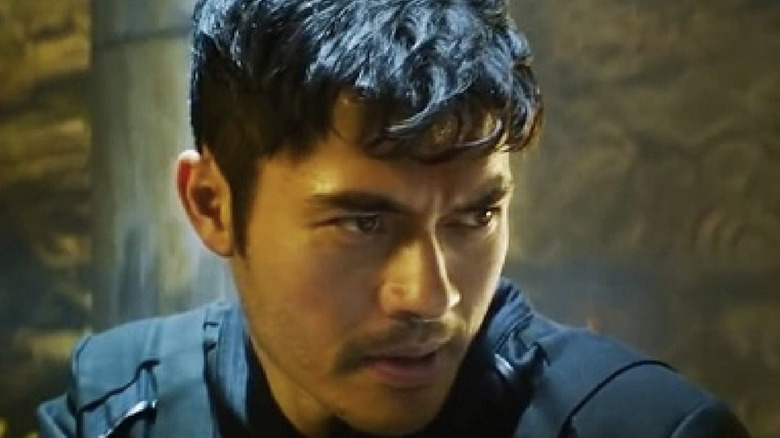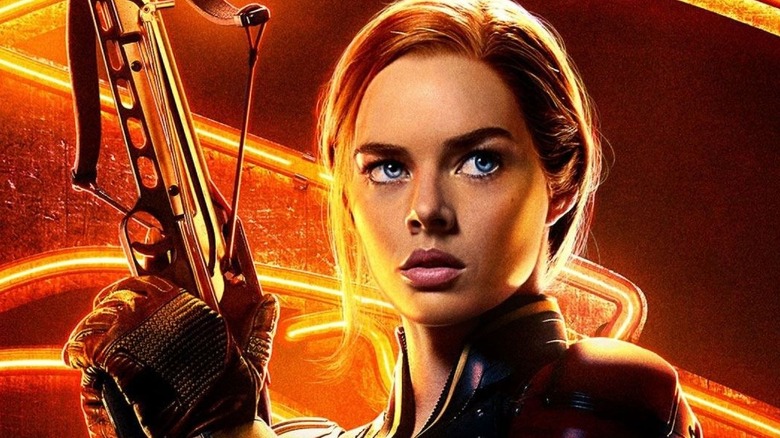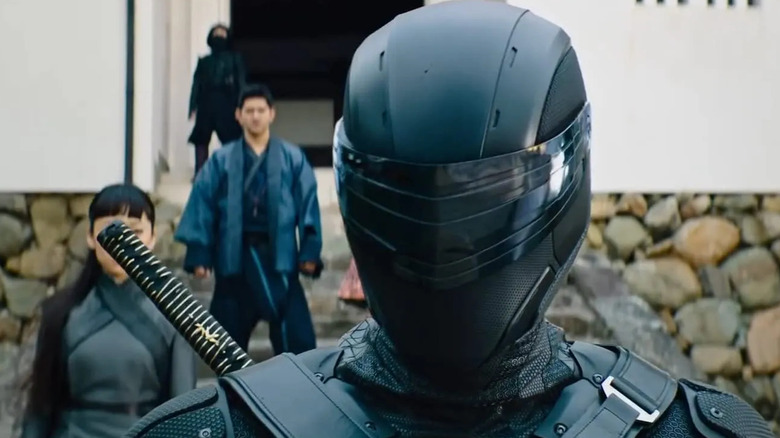Snake Eyes Review: A Real American Head-Scratcher
There has never been a movie quite like "Snake Eyes." This is said with a mixture of appreciation and distaste, commercialism-conceding-weariness and tolerance of an "origin" story but anticipation of better films that seem yet to come. Is the movie a success? Well, that depends on what it is you want to see.
For starters, it's hard to imagine who the audience is for this particular film. If you love and adore Snake Eyes — one of the most beloved '80s pop culture creations in a decade that seemed to mint a new one every week — you're likely already upset by a film that takes the mysterious, mute, never-glimpsed badass and transforms him into a transparent, verbose, rarely-masked badass. If you're too young to remember (or care) about the "Real American Hero" cartoon show and comic books that introduced Snake Eyes, why would you fork over $20 to watch an hour of a somewhat generic martial arts-hero-in-training film that has been done far better in everything from "Kill Bill" to "Redbelt" to the "Cobra Kai" series?
But somehow, almost inexplicably, this prequel to two G.I. Joe movies it would like you to forget (2009's "G.I. Joe: The Rise of Cobra" and 2013's "G.I. Joe: Retaliation") works. By the end, it's hard to not be won over by Henry Golding's wholly new take on the character, the rebooted universe being promised by director Robert Schwentke ("Flightplan"), and a G.I. Joe story that tiptoes around numerous landmines that could have spelled disaster.
"Snake Eyes: G.I. Joe Origins" begins with a flashback that takes place 20 years prior, as a young boy watches his father being taken prisoner by a group of thugs. Much like Two-Face with his coin, the villain promises he'll only kill the man if a roll of the dice goes against him — and when he tosses the bones, they come up snake eyes. The audience is then transported to the current day, when Golding's character goes by the name "Snake Eyes," makes a living cage fighting, and is hellbent on revenge.
This leads to Snake Eyes getting a job with the Yakuza and befriending Tommy (Andrew Koji, "Warrior"), strengthening their bond when he refuses orders to execute the man and the two of them escape together in a well-choreographed action sequence that mixes elements of violence and comedy (how many swords can pierce the cabin of that truck?) evoking classic Jackie Chan films. To show his appreciation, Tommy brings Snake Eyes to Japan, and invites him to join his family's ninja clan, called Arashikage.
Knowing is half the battle — the other half is a quasi-related ninja film
From here, we get a lot of training and drama — some good, some veering dangerously close to yawn-inducing cliches about loyalty, destiny, learning to let go of one's inner failings, you know the drill. The gimmick of the "three trials" that Snake Eyes must pass to join the clan seem well-tread at times, but are creative enough to work, particularly the water test administered with aplomb by the "Hard Master" (Iko Uwais, "The Raid"), a real standout in his limited scenes. Also watching over Snake Eyes' development are Arashikage gatekeepers Akiko (Haruka Abe, "Cruella"), the Blind Master (Peter Mensah, "Agents of S.H.I.E.L.D.") and Sen (veteran "Ultraman" actress Eri Ishida), with all actors providing solid supporting color.
After nearly an hour of this, with the only acknowledgement of the G.I. Joe franchise being the occasional mention of the name "snake eyes" (which is frequently cut down to a simple "Snake"), fans finally get to taste the carrot on the end of this stick. Tommy is told that he resembles "The shadow before the storm," a none-too-subtle acknowledgement he's on the path to becoming frequent Cobra agent (and mortal enemy of Snake Eyes) Storm Shadow. Within moments, boxes of illegal weaponry are glimpsed bearing the Cobra logo, splitting the film into an "A" story (Snake Eyes and Tommy swearing allegiance to Clan Arashikage and taking on a power-hungry exile named Kenta, played by "Giri/Haji" actor Takehiro Hira) and a "B" story (a Cobra/Joe conflict has been going on for decades, and both men will soon choose opposite sides).
This is also about the time that Scarlett and the Baroness show up. Both are classic "Real American Hero" characters, and both come across much better than they have in previous live-action incarnations. With Samara Weaving ("Ready or Not") as the G.I. Joe recruiter and Úrsula Corberó (from the "Snatch" TV series) as the Cobra rep, the two get involved in the story — and even form a temporary alliance to get out of a tough spot together. Weaving, in particular, brings an offbeat charm to the role that has potential for further expansion.
This all builds to a third act that not only has some very impressive stunt pieces (a battle atop a car carrier is particularly cool), but also features a cacophony of world-building plot reveals that drops names (like General Joe Colton), alludes to future battles (Storm Shadow promises to kill Snake Eyes the next time they see each other) and finally, thankfully puts Snake Eyes in his signature mask for one blink-and-you'll-miss-it moment at the end.
The only face mask we wanted to see in 2021
The biggest shortcomings of "Snake Eyes" all seem to orbit the Kenta character. His motivations are vague, he spends his biggest moments wielding a glowing jewel that makes people spontaneously combust, and we're told he has connections to Cobra but he doesn't seem to be any sort of identifiable character from any previous incarnation. It's obvious from the get-go which fate awaits him, and his scenes are mostly token bad-guy stuff.
One of the strange things about "Snake Eyes" is that everything good about it can be attributed to Golding — a charismatic, physically believable actor who deserves to be a bigger star. Yet the best a G.I. Joe fan can hope for in future sequels is that they figure out a way to rob him of his voice, put him under that mask, yet somehow retain his ample contributions. It worked for Pedro Pascal on "The Mandalorian," so who knows? Maybe there is a way.
A similar sentiment could be expressed for Koji as Storm Shadow, also well-cast but hardly the character fans fell in love with decades ago. If handled correctly, "Snake Eyes" could be the sort of film that lays a foundation that would grant power to future scenes between these two — think about how the MCU has set itself up to make maximum impact out of scenes involving, say, Black Widow and Hawkeye — but at worst, too much more character revelation could put them on the path to Patton Oswalt's prophetic comedy bit about how Hollywood needs to stop explaining where the stuff we love comes from.
Here's hoping "Snake Eyes" is the start of a new G.I. Joe rebirth, one that brings us solid cinematic depictions of Serpentor, Gung Ho, the B.A.T. troopers, the USS Flagg aircraft carrier, and/or the brilliant "There's No Place Like Springfield" storyline. Heck, William "Refrigerator" Perry is still with us, let's get him and Sgt. Slaughter a cameo. Here's also hoping we've seen the last of entire hours of G.I. Joe movies that play more like standard-issue martial arts training movies, and that somewhere in between, this series can find a sweet spot that appeals to nerds and newbies alike.


